
Concept explainers
(a)
Interpretation:
The structure of all products formed in the given reaction is to be shown.
Concept Introduction:
The compounds which have same molecular formula but different connectivity of atoms are known as constitutional isomers. Chiral compounds are those compounds which contain an asymmetric carbon atom. Chiral molecules are optically active molecules. Stereocentre can be an atom, bond, or any point in molecule at which interchange of two groups form a stereoisomer.
Answer:
(1) The structures of all products formed in the given reactions are shown below.
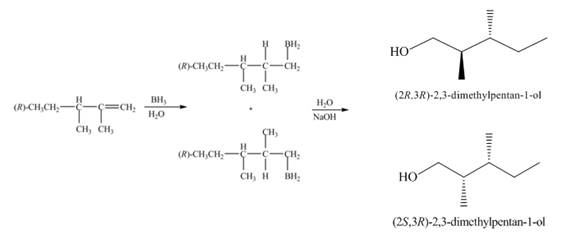
(2) The structures of all products formed in the given reactions are shown below.
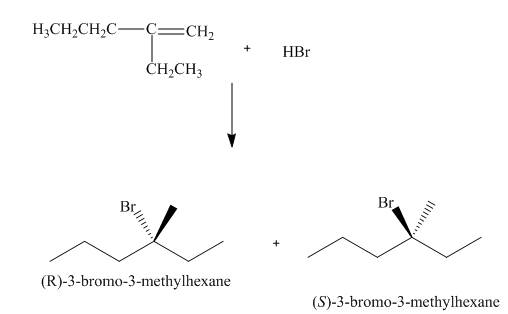
(3) The structures of all products formed in the given reactions are shown below.
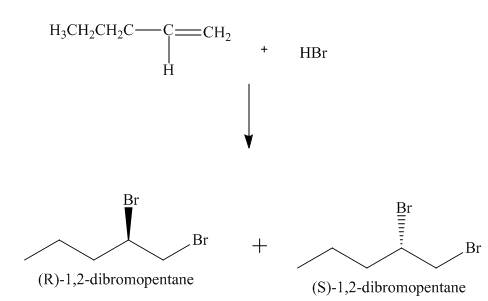
(4) The structures of all products formed in the given reactions are shown below.
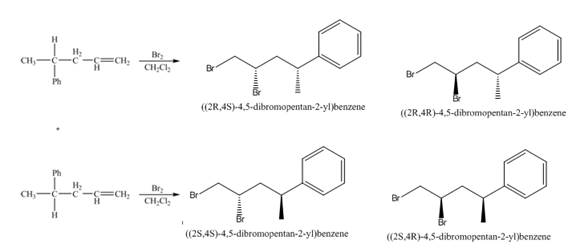
(5) The structures of all products formed in the given reactions are shown below.

(6) The structures of all products formed in the given reactions are shown below.

Explanation:
(1) The
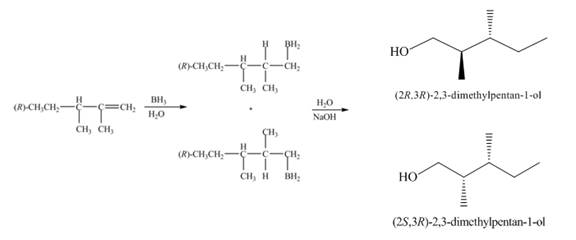
Figure 1
(2) The electrophilic addition of hydrogen bromide takes place on the carbon-carbon double bond of the alkene. The addition follows markonikov’s rule, the hydrogen atom goes to the less substituted carbon atom. The products formed in the given reaction are shown below.

Figure 2
(3) The addition reaction of bromine on the alkene takes place. The addition of bromine on alkene is anti addition. The cyclic bromonium ion intermediate is formed in the reaction. The product formed in the given reaction is shown below.

Figure 3
(4) The addition reaction of bromine on the alkene takes place. The addition of bromine on alkene is anti addition. The cyclic bromonium ion intermediate is formed in the reaction. The product formed in the given reaction is shown below.
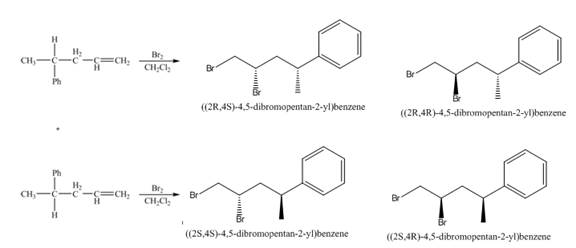
Figure 4
(5) In the reduction reaction of alkene in presence of palladium metal the hydrogen gets adsorbed on the metal surface. Alkene reduction to form

Figure 5
(6) In the reduction reaction of alkene in presence of palladium metal,

Figure 6
Conclusion:
The products formed in the given reactions are shown in Figure 1, Figure 2, Figure 3, Figure 4, Figure 5 and Figure 6.
Answer to Problem 7.42AP
(1) The structures of all products formed in the given reactions are shown below.

(2) The structures of all products formed in the given reactions are shown below.

(3) The structures of all products formed in the given reactions are shown below.

(4) The structures of all products formed in the given reactions are shown below.

(5) The structures of all products formed in the given reactions are shown below.

(6) The structures of all products formed in the given reactions are shown below.

Explanation of Solution
(1) The alkene undergoes hydroboration-oxidation reaction to form alcohol compounds. The borane gets added to the double bond. Then it will undergo oxidation reaction to form the alcohol compound. The products formed in the given reaction are shown below.

Figure 1
(2) The electrophilic addition of hydrogen bromide takes place on the carbon-carbon double bond of the alkene. The addition follows markonikov’s rule, the hydrogen atom goes to the less substituted carbon atom. The products formed in the given reaction are shown below.

Figure 2
(3) The addition reaction of bromine on the alkene takes place. The addition of bromine on alkene is anti addition. The cyclic bromonium ion intermediate is formed in the reaction. The product formed in the given reaction is shown below.

Figure 3
(4) The addition reaction of bromine on the alkene takes place. The addition of bromine on alkene is anti addition. The cyclic bromonium ion intermediate is formed in the reaction. The product formed in the given reaction is shown below.

Figure 4
(5) In the reduction reaction of alkene in presence of palladium metal the hydrogen gets adsorbed on the metal surface. Alkene reduction to form alkane takes place forming syn addition product. The products formed in the given reaction are shown below.

Figure 5
(6) In the reduction reaction of alkene in presence of palladium metal,

Figure 6
The products formed in the given reactions are shown in Figure 1, Figure 2, Figure 3, Figure 4, Figure 5 and Figure 6.
(b)
Interpretation:
The stereochemical relationship between products formed is to be stated.
Concept Introduction:
Stereoisomers which are non-superimposable and not mirror image are known as diastereomer. The compound must contain two or more than two stereocentre. Diastereomer are non identical stereoisomers. The pair of stereoisomer which are mirror image of each other are known as enantiomers. Enantiomers are non-congruent mirror images. If the molecules are placed on top of each other they will not give same molecule.
Answer to Problem 7.42AP
(1) The products formed are diastereomers.
(2) The products formed are enantiomers.
(3) The products formed are enantiomers.
(4) The two pairs of products formed are diastereomers.
(5) Only one product is formed.
(6) Only one product is formed.
Explanation of Solution
(1) The products formed are non-congruent and not mirror image of each other. Hence they are diastereomers.
(2) The products formed are non-congruent mirror image of each other. Therefore, they are enantiomers.
(3) The products formed are non-congruent mirror image of each other. Therefore, they are enantiomers.
(4) The products formed are non-congruent and not mirror image of each other. Hence they are diastereomers.
(5) Only one product is formed.
(6) Only one product is formed.
The stereochemical relationship between products formed in reaction (1) and (4) are diastereomers and reaction (2) and (3) are enantiomers.
(c)
Interpretation:
The products are formed in identical or different amount is to be stated.
Concept Introduction:
The electrophilic addition reaction on the alkene can takes place from any side of alkene. The electrophile can attack the carbon double bond from above or below the plane. The probability of attack from both sides is equal.
Answer to Problem 7.42AP
(1) The products are formed in equal amount.
(2) The products are formed in equal amount.
(3) The products are formed in equal amount.
(4) The products are formed in equal amount.
(5) Only one product is formed.
(6) Only one product is formed.
Explanation of Solution
(1) The alkene is a planar molecule. The reaction on the carbon-carbon double bond of alkene can takes place from above or below the plane. Therefore, products are formed in equal amount.
(2) The alkene is a planar molecule. The reaction on the carbon-carbon double bond of alkene can takes place from above or below the plane. Therefore, products are formed in equal amount.
(3) The alkene is a planar molecule. The reaction on the carbon-carbon double bond of alkene can takes place from above or below the plane. Therefore, products are formed in equal amount.
(4) The alkene is a planar molecule. The reaction on the carbon-carbon double bond of alkene can takes place from above or below the plane. Therefore, products are formed in equal amount.
(5) Only one product is formed.
(6) Only one product is formed.
The products are formed in equal amount in reaction (1), (2), (3), (4) and only one product is formed in reaction (5) and (6).
(d)
Interpretation:
The products which have different physical properties is to be stated.
Concept Introduction:
Stereoisomers which are non-superimposable and not mirror image are known as diastereomer. The compound must contain two or more than two stereocentre. Diastereomer are non identical stereoisomers. The pair of stereoisomer which are mirror image of each other are known as enantiomers. Enantiomers are non-congruent mirror images. Diastereomers shows different physical properties and enantiomers show same physical properties.
Answer to Problem 7.42AP
(1) The products formed in the given reaction will have different physical properties.
(2) The products formed in the given reaction will have identical physical properties.
(3) The products formed in the given reaction will have identical physical properties.
(4) The products formed in the given reaction will have different physical properties.
(5) Only one product is formed.
(6) Only one product is formed.
Explanation of Solution
(1) The products formed in the given reaction are diastereomer. Diastereomers show different physical properties. Therefore, the products formed in the given reaction will have different physical properties.
(2) The products formed in the given reaction are enantiomers. Enantiomers show identical physical properties. Therefore, the products formed in the given reaction will have identical physical properties.
(3) The products formed in the given reaction are enantiomers. Enantiomers show identical physical properties. Therefore, the products formed in the given reaction will have identical physical properties.
(4) The products formed in the given reaction are diastereomer. Diastereomers show different physical properties. Therefore, the products formed in the given reaction will have different physical properties.
(5) Only one product is formed.
(6) Only one product is formed.
The products formed in the reaction (1) and reaction (4) will have different physical properties. The products formed in the reaction (2) and reaction (3) will have identical physical properties. In reaction (5) and (6) only one product is formed.
Want to see more full solutions like this?
Chapter 7 Solutions
ORGANIC CHEM +SG +SAPLING >IP<
- Ggggffg2258555426855 please don't use AI Calculate the positions at which the probability of a particle in a one-dimensional box is maximum if the particle is in the fifth energy level and in the eighth energy level.arrow_forwardExplain the concepts of hemiacetal and acetal.arrow_forwardBriefly describe a nucleophilic addition.arrow_forward
- Is nucleophilic acyl substitution an SN1 or SN2 reaction?arrow_forwardDraw product A, indicating what type of reaction occurs. NH2 F3C CF3 NH OMe NH2-NH2, ACOH Aarrow_forwardPhotochemical smog is formed in part by the action of light on nitrogen dioxide. The wavelength of radiation absorbed by NO2 in this reaction is 197 nm.(a) Draw the Lewis structure of NO2 and sketch its π molecular orbitals.(b) When 1.56 mJ of energy is absorbed by 3.0 L of air at 20 °C and 0.91 atm, all the NO2 molecules in this sample dissociate by the reaction shown. Assume that each absorbed photon leads to the dissociation (into NO and O) of one NO2 molecule. What is the proportion, in parts per million, of NO2 molecules in this sample? Assume that the sample behaves ideally.arrow_forward
- Correct each molecule in the drawing area below so that it has the skeletal ("line") structure it would have if it were dissolved in a 0.1 M aqueous solution of HCI. If there are no changes to be made, check the No changes box under the drawing area. No changes. HO Explanation Check NH, 2 W O :□ G ©2025 M unter Accessibilityarrow_forwardAn expression for the root mean square velocity, vrms, of a gas was derived. Using Maxwell’s velocity distribution, one can also calculate the mean velocity and the most probable velocity (mp) of a collection of molecules. The equations used for these two quantities are vmean=(8RT/πM)1/2 and vmp=(2RT/M)1/2 These values have a fixed relationship to each other.(a) Arrange these three quantities in order of increasing magnitude.(b) Show that the relative magnitudes are independent of the molar mass of the gas.(c) Use the smallest velocity as a reference for establishing the order of magnitude and determine the relationship between the larger and smaller values.arrow_forwardThe reaction of solid dimethylhydrazine, (CH3)2N2H2, and liquefied dinitrogen tetroxide, N2O4, has been investigated for use as rocket fuel. The reaction produces the gases carbon dioxide (CO2), nitrogen (N2), and water vapor (H2O), which are ejected in the exhaust gases. In a controlled experiment, solid dimethylhydrazine was reacted with excess dinitrogen tetroxide, and the gases were collected in a closed balloon until a pressure of 2.50 atm and a temperature of 400.0 K were reached.(a) What are the partial pressures of CO2, N2, and H2O?(b) When the CO2 is removed by chemical reaction, what are the partial pressures of the remaining gases?arrow_forward
- One liter of chlorine gas at 1 atm and 298 K reacts completely with 1.00 L of nitrogen gas and 2.00 L of oxygen gas at the same temperature and pressure. A single gaseous product is formed, which fills a 2.00 L flask at 1.00 atm and 298 K. Use this information to determine the following characteristics of the product:(a) its empirical formula;(b) its molecular formula;(c) the most favorable Lewis formula based on formal charge arguments (the central atom is N);(d) the shape of the molecule.arrow_forwardHow does the square root mean square velocity of gas molecules vary with temperature? Illustrate this relationship by plotting the square root mean square velocity of N2 molecules as a function of temperature from T=100 K to T=300 K.arrow_forwardDraw product B, indicating what type of reaction occurs. F3C CF3 NH2 Me O .N. + B OMearrow_forward
 ChemistryChemistryISBN:9781305957404Author:Steven S. Zumdahl, Susan A. Zumdahl, Donald J. DeCostePublisher:Cengage Learning
ChemistryChemistryISBN:9781305957404Author:Steven S. Zumdahl, Susan A. Zumdahl, Donald J. DeCostePublisher:Cengage Learning ChemistryChemistryISBN:9781259911156Author:Raymond Chang Dr., Jason Overby ProfessorPublisher:McGraw-Hill Education
ChemistryChemistryISBN:9781259911156Author:Raymond Chang Dr., Jason Overby ProfessorPublisher:McGraw-Hill Education Principles of Instrumental AnalysisChemistryISBN:9781305577213Author:Douglas A. Skoog, F. James Holler, Stanley R. CrouchPublisher:Cengage Learning
Principles of Instrumental AnalysisChemistryISBN:9781305577213Author:Douglas A. Skoog, F. James Holler, Stanley R. CrouchPublisher:Cengage Learning Organic ChemistryChemistryISBN:9780078021558Author:Janice Gorzynski Smith Dr.Publisher:McGraw-Hill Education
Organic ChemistryChemistryISBN:9780078021558Author:Janice Gorzynski Smith Dr.Publisher:McGraw-Hill Education Chemistry: Principles and ReactionsChemistryISBN:9781305079373Author:William L. Masterton, Cecile N. HurleyPublisher:Cengage Learning
Chemistry: Principles and ReactionsChemistryISBN:9781305079373Author:William L. Masterton, Cecile N. HurleyPublisher:Cengage Learning Elementary Principles of Chemical Processes, Bind...ChemistryISBN:9781118431221Author:Richard M. Felder, Ronald W. Rousseau, Lisa G. BullardPublisher:WILEY
Elementary Principles of Chemical Processes, Bind...ChemistryISBN:9781118431221Author:Richard M. Felder, Ronald W. Rousseau, Lisa G. BullardPublisher:WILEY





